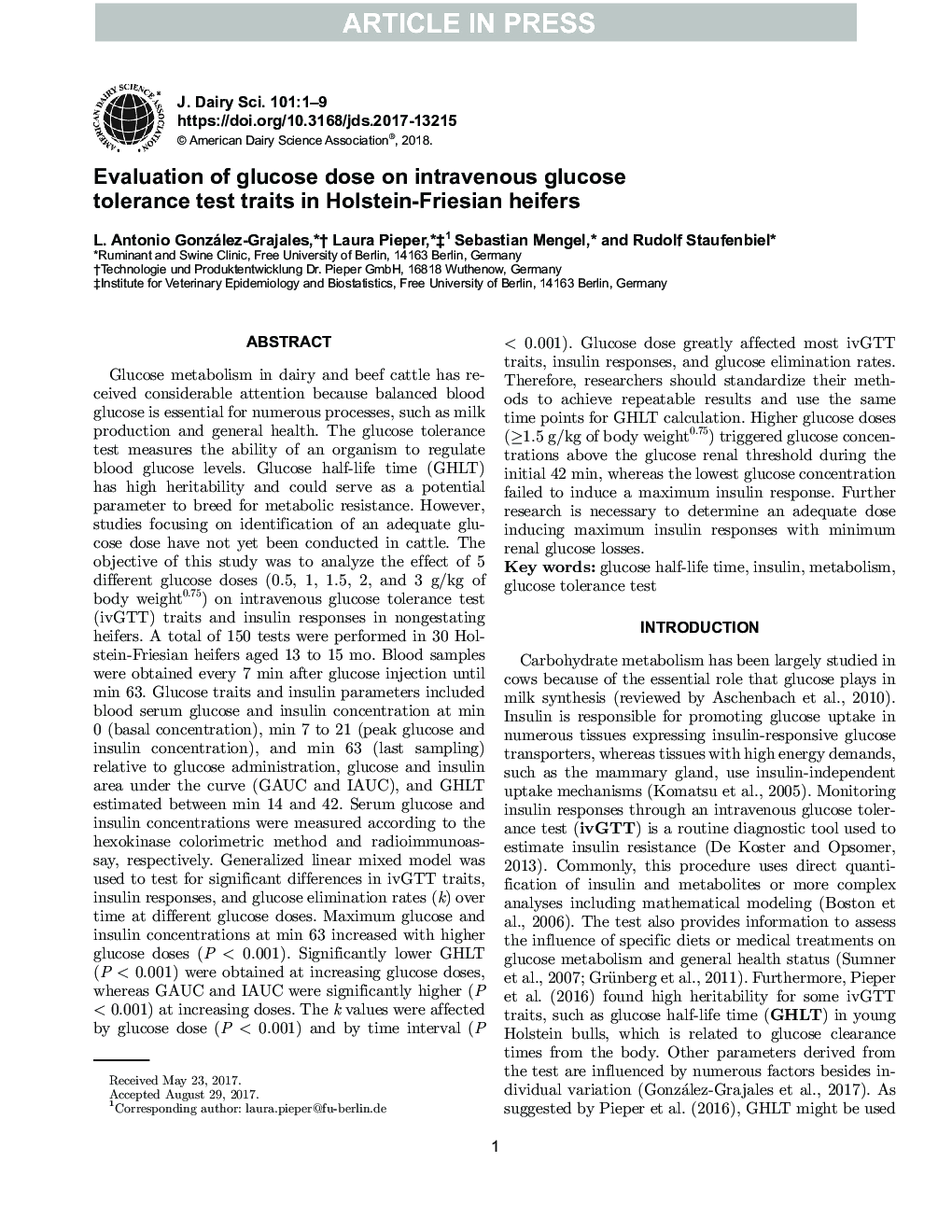| کد مقاله | کد نشریه | سال انتشار | مقاله انگلیسی | نسخه تمام متن |
|---|---|---|---|---|
| 8501794 | 1553844 | 2018 | 9 صفحه PDF | دانلود رایگان |
عنوان انگلیسی مقاله ISI
Evaluation of glucose dose on intravenous glucose tolerance test traits in Holstein-Friesian heifers
ترجمه فارسی عنوان
بررسی میزان دوز گلوکز بر صفات تست تحمل گلوکز داخل وریدی در تلیسه های هولشتاین-فریزیان
دانلود مقاله + سفارش ترجمه
دانلود مقاله ISI انگلیسی
رایگان برای ایرانیان
کلمات کلیدی
گلوکز نیمه عمر، انسولین، متابولیسم تست تحمل گلوکز،
موضوعات مرتبط
علوم زیستی و بیوفناوری
علوم کشاورزی و بیولوژیک
علوم دامی و جانورشناسی
چکیده انگلیسی
Glucose metabolism in dairy and beef cattle has received considerable attention because balanced blood glucose is essential for numerous processes, such as milk production and general health. The glucose tolerance test measures the ability of an organism to regulate blood glucose levels. Glucose half-life time (GHLT) has high heritability and could serve as a potential parameter to breed for metabolic resistance. However, studies focusing on identification of an adequate glucose dose have not yet been conducted in cattle. The objective of this study was to analyze the effect of 5 different glucose doses (0.5, 1, 1.5, 2, and 3 g/kg of body weight0.75) on intravenous glucose tolerance test (ivGTT) traits and insulin responses in nongestating heifers. A total of 150 tests were performed in 30 Holstein-Friesian heifers aged 13 to 15 mo. Blood samples were obtained every 7 min after glucose injection until min 63. Glucose traits and insulin parameters included blood serum glucose and insulin concentration at min 0 (basal concentration), min 7 to 21 (peak glucose and insulin concentration), and min 63 (last sampling) relative to glucose administration, glucose and insulin area under the curve (GAUC and IAUC), and GHLT estimated between min 14 and 42. Serum glucose and insulin concentrations were measured according to the hexokinase colorimetric method and radioimmunoassay, respectively. Generalized linear mixed model was used to test for significant differences in ivGTT traits, insulin responses, and glucose elimination rates (k) over time at different glucose doses. Maximum glucose and insulin concentrations at min 63 increased with higher glucose doses. Significantly lower GHLT were obtained at increasing glucose doses, whereas GAUC and IAUC were significantly higher at increasing doses. The k values were affected by glucose dose and by time interval. Glucose dose greatly affected most ivGTT traits, insulin responses, and glucose elimination rates. Therefore, researchers should standardize their methods to achieve repeatable results and use the same time points for GHLT calculation. Higher glucose doses (â¥1.5 g/kg of body weight0.75) triggered glucose concentrations above the glucose renal threshold during the initial 42 min, whereas the lowest glucose concentration failed to induce a maximum insulin response. Further research is necessary to determine an adequate dose inducing maximum insulin responses with minimum renal glucose losses.
ناشر
Database: Elsevier - ScienceDirect (ساینس دایرکت)
Journal: Journal of Dairy Science - Volume 101, Issue 1, January 2018, Pages 774-782
Journal: Journal of Dairy Science - Volume 101, Issue 1, January 2018, Pages 774-782
نویسندگان
L. Antonio González-Grajales, Laura Pieper, Sebastian Mengel, Rudolf Staufenbiel,
